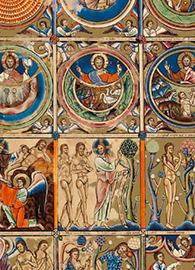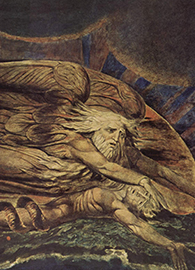Genesis/Exodus Week 2
The Created Order: Genesis 1:1–2:3
Seattle Pacific University Professor of Old Testament
Read this week’s Scripture: Genesis 1:1–2:3
13:37

 Enlarge
Enlarge
You and I had a beginning (obviously!). Everyone had a beginning. A song from the musical The Sound of Music tells us delightfully that the beginning is “a very good place to start.” Scripture, too, begins at the beginning. If you know the Bible at all, you know to refer to this beginning as creation. Literarily speaking, the beginning of any story is strategic. At the same time, you realize almost intuitively that the Bible’s beginning with creation is more than a nod to literary structure. Creation is foundational to everything that follows in Scripture.
Perhaps that is why you cannot help but be taken aback by noticing two stories in Genesis that seem to feature creation: Story 1 (Genesis 1:1–2:3) and Story 2 (Genesis 2:4–25). You no doubt have heard these two narratives referred to as a single account, which then requires a bit of harmonization [see Author’s Note 1]. But harmonizing compels one to ask: If harmonization is necessary, why didn’t the biblical writers save us the trouble?
Actually, a speed-read of Genesis helps us to pose that question differently. Speed-reading reveals a formula which structures the whole book. The formula is quite simple. You find it either as “this is the story of” or “this is the genealogy of,” depending on whether it is followed by a narrative or a genealogy [see Author’s Note 2].
You also discover that the formula introduces rather than summarizes. That in turn makes you realize that only Genesis 1:1–2:3 is not introduced by the formula. It appears that Genesis 1:1–2:3 has been arranged to be read from a different perspective than all the other parts of Genesis governed by the formula. Thus, you may justifiably regard Genesis 1:1–2:3 as the creation story proper, whereas the so-called second creation story (Genesis 2:4–25) is the first episode in which God engages the created order. You and I might be bothered by the contradictory details, but those who put the book together were apparently unfazed.
“Formless and Void”
Still, even when you accept this first narrative as the creation story proper, there’s another difficulty that immediately presents itself. The problem is that you just cannot seem to get your head around the text’s initial images. When I try to envision an earth that is formless and void, darkness that shrouds the deep, and God’s spirit (or a divine wind) hovering over the waters (1:2), my imagination fails. I can manage seeing an earth in my mind’s eye, but not one that has no shape or substance. If darkness surrounds the primordial waters, how can we see any image? And don’t you agree that the very idea of God’s spirit is something that is mysterious, invisible, and impossible to track?
But perhaps that is the point. The biblical image may be purposely designed to frustrate our efforts at imagination. It begins to dawn on us (no pun intended!) that you are confronting a picture of chaos. You know that chaos is not quite nothingness. There is something there. But there is no order, no structure or lines of demarcation, no defining boundaries, and certainly no familiarity. You and I simply cannot negotiate the images. Chaos frustrates, overwhelms, and even frightens us.
A Voice Out of the Void
This is why you cannot help but be amazed by what happens next. Out of this chaotic, formless, dark, roiling, void comes a voice — the voice of God. In the context of chaos God speaks, and everything changes. You hear only three little words (two in Hebrew!) — “And God said”—after which nothing is the same (1:3). You cannot help but note that this initiates a long string of divine speaking (1:3, 6, 9, 11, 14, 20, 24, 26, 28, 29). You also notice divine speech when other vocabulary is used. God “called” the light “day” and the darkness “night” (1:5); “called” the firmament “heaven” (1:8); “called” the dry land “earth” and the waters “seas” (1:10); and “uttered” a blessing (1:22). You realize those are all divine speech acts. Divine speech stamps this narrative.
Relative to these speaking patterns, another feature that you cannot help but notice is the manner in which the created order is designed to obey, so to speak, the divine commands. When God speaks, you observe either something coming into existence for the first time (1:3, 6, 11, 14, 16, 21, 25, 27) or something that already exists contributing further to the created order at divine instigation (1:9, 11–12, 20, 24). If we are inclined to doubt this “hard wiring” of the created order, the narration underscores the results of God’s continuous speaking with the phrase: “and it was so” (1:7, 9, 11, 15, 24, 30).
A Good Creation
You also don’t have to be an expert to see how many times the accent is on the fact that God’s creation is good (1:4, 10, 12, 18, 21, 25, 31). You would be right to surmise that such repetition is extremely important, especially since the totality of creation — the material universe in all aspects, vegetation, the animal world, and humanity — is pronounced good and, ultimately, very good (1:31). A basically, intrinsically, substantially good created order will be amenable to ultimate divine reconciliation, restoration, and redemption should something go wrong.
Then again, you cannot fail to appreciate the importance of light in this profound story, for it is created before anything else (1:3). Then you realize that this light is not associated with any ordinary physical source of light. True, God separates the light from the darkness, and calls the former “day” and the latter “night.”
Yet there is no mention of the heavenly bodies with which we normally associate light until the fourth day (1:14–18). You almost have to conclude that this initial light is, in effect, the ground and presupposition for the whole created order. In this light (pun intended!), you begin to understand the role that light plays in other strategic biblical texts — for example, the Gospel of John [see Author’s Note 3]. This story explains why we live in light rather than darkness, a reality that is greater than any source of light as we normally understand it. Light has overcome darkness.
Order and Symmetry
As well, keeping in mind the chaos depicted at the outset (1:1–2), you revel in the fact that, as the story unfolds, disorder is replaced by order. For example, you cannot miss the linear progression in which the narrative moves easily and naturally from day one to day six and then is capped off by a final seventh day where God rests, not from fatigue but as a kind of joyful satisfaction (1:3–2:3).
Equally, order is prominent when you observe the symmetry of the days of creation, for each of them consists of the same amount of time regardless of what was made on that particular day. Each day is made up of an evening and a morning (1:5, 8, 13, 19, 23, 31). Only the final day does not have this designation [see Author’s Note 4]. Order is emphasized in another feature of the narrative. On the first three days of creation, space is created and then subsequently filled, so to speak, with what God creates on the last three days, respectively [see Author’s Note 5]. We end up with a universe that is orderly, symmetrical, and predictable.

 Enlarge
Enlarge
The Crescendo: Imago Dei
As wonderful as this all is, we get an extra jolt of delight involving humanity. For one thing, you get the idea that the whole of creation has been working toward a crescendo, as if the very last thing created has been the goal all along. Granted, our kind had to share day six with the other creatures (1:24–25), but we were the last thing that God made. This amounts to a certain pride of reverse order. This pride of place, if we can call it that, is no doubt why we humans have been put in charge over those who shared this day of creation with us (1:26).
Even more, our creation is unique in that we alone have been made in the image and likeness of God (1:26–27). Even though God is creator and we remain creatures, we nonetheless bear the very stamp of our maker.
What that means precisely will be spelled out throughout the rest of the biblical material, but everything that it must mean is without question an incomparable good. This item in the creation story may even say something about the famous prohibition against making images and likenesses of God, as expressed famously in the Ten Commandments but found throughout the Bible (Exodus 20:4). It is as though God is saying that making an image or likeness of the divine self is not only anti-God, but anti-human. That is because God has already provided the world with the divine image: human beings are that image.
Male and Female
We also have to be impressed that the divine image is expressed in human maleness and femaleness together. First we hear God in effect talking aloud: “Let us make humanity in our image, after our likeness.”
Then, when God creates humanity, the male and the female appear simultaneously: “male and female made He them” [see Author’s Note 6]. We would be wrong to conclude that this speaks to divine sexuality. But we would not be incorrect to see this as a stunning statement about the glorious role of humanity in the created order and the manner in which human maleness and femaleness reflects not only the fullness and wholeness of humanity, but in some sense the divine image itself.
Given this understanding of humanity, Christians will understand one day that the claim that God was in Christ accords fully with what the Bible teaches in its creation story.
Questions for Further Reflection: Genesis 1:1–2:3
- In light of the theological and religious emphases in this passage, what is a Christian obligated to believe about creation on the basis of this text? In other words, what are the nonnegotiables based on what the text tells us?
- Some in the Church have interpreted the creation story as oriented to scientific statements or even verified by scientific methods. What can scientists assert as scientists about God’s creating, or God’s speaking, or the created order being good, or about human beings made in the image of God?
- What are some possible ethical implications of human beings being made in the image and likeness of God?
- Does the claim that the biblical creation story is true require that it also be historically or scientifically verifiable? Why, or why not?
- As is well known, Christians often discuss a number of topics — such as the age of the earth, the Big Bang, macro- or micro-evolution, the existence of dinosaurs, how long homo sapiens have been on the earth, and the like — when reflecting on the creation story. What should be made of the fact that the text itself seems to say virtually nothing about such topics?

This work is licensed under a Creative Commons License.





I am enjoying this “beginning” to the beginning of creation. You mentioned once we read “and God said” nothing is the same. I like to couple this phrase with Isaiah 55:11 – “so is my word that goes out from my mouth: It will not return to me empty, but will accomplish what I desire and achieve the purpose for which I sent it.”
I look forward to future weeks of study.
yes and enjoy “begins to dawn on us (no pun intended!) “
we have the prophetic word made more sure, to which we do well to pay attention as to a lamp shining in a dark place,
until the day dawns and the morning star arises in our hearts! 2 Peter 1:19